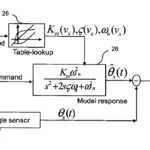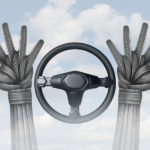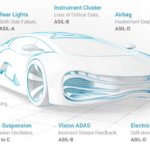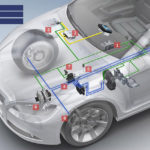Cars with lane-keeping assistance (LKA) also are mandated to have a hands-off detection (HOD) function; there are several ways to meet this challenging requirement.
Despite the BOM advantages of torque-based HOD, it has performance issues. Capacitive-based sensing is a viable alternative approach.
Capacitive sensing for HOD monitors the driver’s grip on the steering wheel by detecting the change in capacitance of the steering wheel when the driver’s hands – which absorb electrical charge – come into contact with it. This technique only requires a single sensor chip connected to a metal sensor element built into the steering wheel (Figure 1).
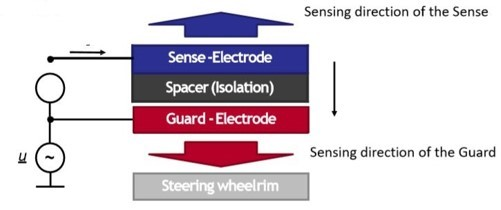
Capacitive-based sensing is a well-understood technique, as it has been applied for many years in products such as touchscreens and touch-sensing buttons. One vendor’s physical implementation (IEE) uses a highly flexible multi-layer sensor mat integrated into the steering wheel, with a miniaturized electronic and the connecting cabling installed in the steering wheel’s center hub (Figure 2). The system measures the current flowing from the sensing electrode towards vehicle ground, proportional to the capacitance. If a driver touches the steering wheel, the capacitance increases, resulting in a change current which can be detected.

Simple capacitive-based sensing is an effective approach even if the driver wears gloves, has moist hands, or conditions are humid. Further, it is not compromised even if the driver wedges an object which affects the capacitive field into the frame of the steering wheel, such as a piece of fruit or a plastic water bottle (note that torque-based systems can be “fooled” by such wedging or using knees to “hold” the wheel) . However, automakers continually seek further enhancements and assurances when implementing safety-related features. There are modifications to the basic capacitive-sensing approach which extend the performance and consistency of this technique beyond the basic approach.
One solution is to enhance the simple sensor (transducer). More advanced classification is enabled by using a multi-zone HOD system which determines, for example, between a left and/or right-hand touch and the approach used by Alps Alpine (Figure 3).
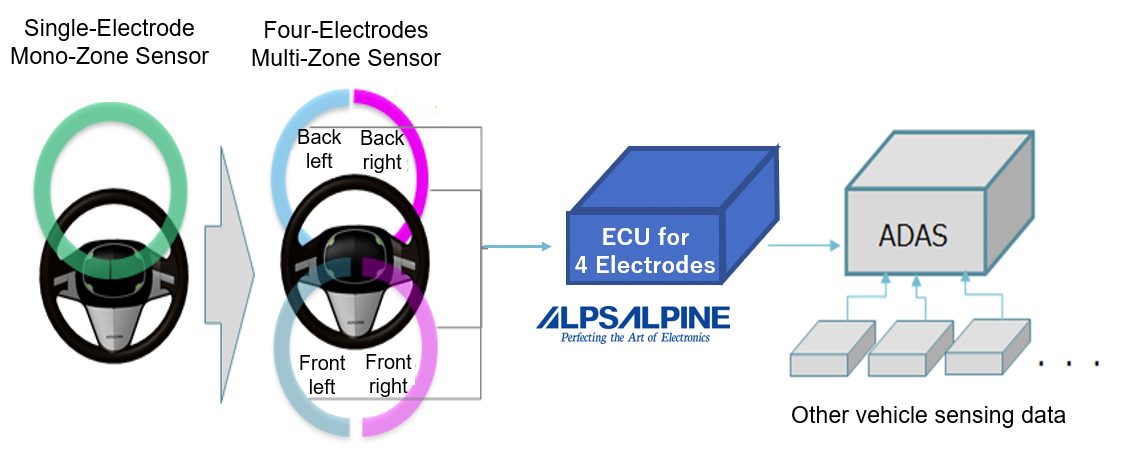
By dividing the steering wheel and grip patterns into smaller sections, more-efficient system switching and enhanced touch assessment reliability is possible. The sensor electrode is divided into four sections to identify various grip states, which allows for a more detailed assessment of driving status than a basic touching/not touching determination reached using an existing single-electrode sensor.
Even this approach still has limits and false indications. Some vendors use advanced modulation for the sensor with in-phase/quadrature (I/Q) modulation and synchronous demodulation to compensate for this shortcoming. Like the capacitive charge-discharge method, I/Q modulation and demodulation are proven and well-known techniques for capacitive sensing. Unlike that simpler method, however, the use of I/Q signals measures the resistive and the capacitive element of a system’s impedance, which enhances performance and is conceptually analogous to digital bit error rate.
As a result, its proponents, such as AMS-Osram with their AS8579 capacitive sensor IC (Figure 4), maintain that it works more reliably than basic capacitive sensing even under challenging conditions such as in the presence of moisture or when the driver is wearing gloves. The IC captures the current flow of a metal object and applies algorithms to determine the capacitive and resistive impedance through the steering wheel.

The IC can be read via an SPI interface used for IC setup and configuration. They also claim an added benefit of the AS8579-based solution: it can operate via a heated steering wheel’s heater element, so it does not require a separate sensor element to be built into the steering wheel.
In summary, automobile engineers have multiple ways of meeting the required HOD mandate imposed due to the presence of lane-keeping assistance. They can use torque-based algorithms or one of several capacitance-based approaches.
But those are not the only possibilities. Researchers are developing and evaluating very different approaches contact-free approaches. One such leading-edge method is based on an infrared camera located over the driver’s shoulder, which is used to image and interpret the position of the backs of the driver’s hands. As of now, these are only investigative projects in the lab, but as the old cliché says, “you never know what the future will bring.”
Related EE World Content
- The automotive Tire Pressure Monitoring System, Part 1: The situation
- The automotive Tire Pressure Monitoring System, Part 2: Perspectives
- The automotive Tire Pressure Monitoring System, Part 3: Implementation
- The automotive Tire Pressure Monitoring System, Part 4: Issues
- Understanding stop/start automobile-engine design, Part 1: The idea
- Understanding stop/start automobile-engine design, Part 2: The starter motor
- Understanding stop/start automobile-engine design, Part 3: The battery situation
- Understanding stop/start automobile-engine design, Part 4: Mechanical wear issues
- Understanding stop/start automobile-engine design, Part 5: Additional considerations
- Understanding stop/start automobile-engine design, Part 6: Responses and work-arounds
References
- The Wall Street Journal, “ Ding. Chirp. Notifications Are Driving Us Crazy.”
- Jeep Garage, “2019 Cherokee Trailhawk Elite hands off steering wheel alerts”
- Driving, “Lorraine Explains: You can take your hands off the wheel — should you?”
- Subaru Outback, “Hands on the steering wheel warning”
- LinkedIn, “Hands-Off Detection (HOD) – crucial for Driver Assistance and Automated Driving Systems” [capacitive overview]
- EE News Automotive, “Hands-off detection ECU for Autonomous Driving Systems” [Alps Alpine capacitive system]
- National Highway Traffic Safety Administration (NHTSA), “Hands Off Detection Requirements for UN R79 Regulated Lane Keeping Assist Systems” [IEE capacitive solution]
- IEE, “Hands Off Detection (HOD) Sensing System” [IEE capacitive solution]
- IEE/YouTube, “EE – Hands Off Detection (HOD) sensing system” [IEE capacitive solution]
- US Patent US7912665B2/General Motors, “Method and apparatus for driver hands off detection for vehicles with active front steering system“ [torque-based scheme]
- JTEKT ENGINEERING JOURNAL, “Hands On/Off Detection Based on EPS Sensors” [academic paper on torque system]
- AMS-Osram, “Hands-on detection webinar about capacitive sensor technology” [Quadrature scheme]
- AMS-Osram, “New capacitive sensing technology provides a more reliable and safer hands-on detection” [Quadrature scheme]
- AMS-Osram, “Hands-on Detection” (video)
- AMS-Osram, AS8579 Capacitive Sensor data sheet
- Zoppas Industries, “Steering Wheel Hand Detection Systems” [capacitive sensing plus integral heater]
- Microchip Technology/YouTube, “Steering Wheel Demonstration w/ Capacitive Hands off Detection, Touch Pads and Buttons” [capacitive sensing]
- The National Academies of Sciences, Engineering, and Medicine “Hands Off Detection Requirements for UN R79 Regulated Lane Keeping Assist Systems” [“legal” notice on LKA and HOD]
- IEEE, “Hands on the wheel: a Dataset for Driver Hand Detection and Tracking” [use of infrared imaging of back of driver’s hands]
- United Nations Economic Commission for Europe, “World Forum for the harmonization of vehicle regulations” [Role of UN ECE]

